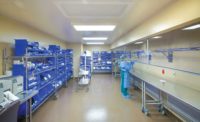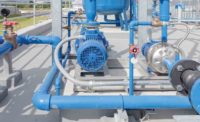Few indoor environments must be as meticulously managed as medical facilities.
The threat of health care associated infections (HAIs), airborne diseases, sterilization, etc., make health care facilities challenging environments for HVACR designers.
Stakeholders responsible for the planning, design, construction, and operation of such facilities connected at the 31st Healthcare Facilities Symposium and Expo (HFSE), held Oct. 8-10 in Austin, Texas, where attendees formed a think tank designed to examine and solve these challenges and more.
USP 797
One of the conference’s sessions focused on the evolution of U.S. Pharmacopeial Convention (USP) 797, “Pharmaceutical Compounding – Sterile Preparations.”
USP 797, which was designed to ensure that drugs being infused into patients are created in the safest of pharmaceutical environments, is currently undergoing a public review.
More than 8,000 written comments have been received since the public comment period opened in September 2015. Comments will continue to be accepted until Nov. 30. A final version of the standard is expected to become official Dec. 1, 2019.
Proposed changes to 797 require that a cleanroom suite be continuously maintained at 20°C or cooler and maintain a relative humidity below 60 percent. Previously, the air provided to a buffer room simply had to be filtered using a HEPA filter. Current revisions require that such a HEPA filter be physically located in the buffer room. Additionally, air returns must be located low on the wall, and negative pressure must be maintained between 0.01-0.03 inch of water column relative to all adjacent areas.
The standards committee also suggests that dust-collecting overhangs be minimized and that surfaces be resistant to damage by cleaning agents.
THE JOHNS HOPKINS WAY
For large outfits, such as Johns Hopkins Health System (JHHS), making the physical changes necessary to adhere to this standard could prove costly.
Initial calculations determined that JHHS would have to spend $600,000 in each of its 25 pharmacies, or $15 million total, to meet the standard’s proposed updates.
“We pulled together our team of design professionals and toured every single pharmacy,” said Tonia E. Burnette, RA, senior director of architecture and planning, JHHS. “We assumed we were going to have to create segregated compounding areas [SCAs] and/or buffer rooms in each of our pharmacies, but there simply wasn’t room to do that. All we saw were dollar signs.”
JHHS’ design team began brainstorming potential solutions and emerged with a Compounding Pharmacy Assessment Tool designed to help decipher which of its facilities met the standard and where discrepancies existed. The workflow diagram displayed how air enters and leaves each room as well as identified problem areas across all new USP 797 requirements. Using the tool, the design team created a corrective action plan to fix the problem areas.
“There were excursions that had to be fixed, and our tool helped us precisely address those areas,” said Kevin L. Bernhard, planner of architecture and planning, JHHS. “We were able to turn our list of deficiencies into a scope of work and focus on fixing the problem areas.”
The assessment tool helped JHHS identify that 10 of its 25 pharmacies did not need to compound hazardous or sterile drugs, eliminating them from USP 797 concerns.
“We ultimately determined that one pharmacy needed to be completely redone,” Bernhard said. “That left us with 14 pharmacies that needed some work. Using our tool, we were able to lower our expenditures to $78,000 per pharmacy, which reduced our total from $15 million to about $1.1 million.”
CREATIVE SOLUTIONS
No pharmacy is exempt from USP 797 (or its “sister” regulation, USP 800). Now’s the time to assess any USP 797 issues in your facilities and perhaps craft a creative solution like JHHS. The team at JHHS is willing to share its tool, just as long as you provide them with some feedback. If you’re interested in JHHS’ tool, contact me, and I’ll connect you with the proper individuals. For more information on USP 797, visit here.
ES WEBINARS
Register for our free webinars at http://webinars.esmagazine.com, where users can also view any webinar from the last year on demand in our archive.
NOVEMBER 7
The Generator: Understanding
Capacity Ratings
Presented by Julius Neudorfer
Sponsored by Kohler
DECEMBER 12
Electrical Protection of Standby
Generators
Presented by Tim Coyle
Sponsored by Kohler
INDUSTRY EVENTS
Nov. 13-15
Autodesk University
Las Vegas
au.autodesk.com
Nov. 13-15
Groundbreak 2018
Austin, Texas
www.procore.com
Nov. 14-16
Greenbuild International Conference and Expo
Chicago
www.greenbuildexpo.com





